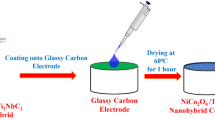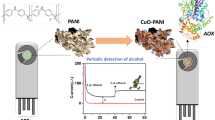Abstract
Alumina inorganic molecularly imprinted polymer (MIP) modified multi-walled carbon nanotubes (MWCNTs) on a glassy carbon electrode (MWCNTs-Al2O3-MIP/GCE) was firstly designed and fabricated by one-step electro deposition technique for the detection of uric acid (UA) in sweat. The UA templates were embedded within the inorganic MIP by co-deposition with Al2O3. Through the evaluation of morphology and structure by Field Emission Scanning Electron Microscope (SEM), Energy Dispersive X-ray Spectroscopy (EDS), X-ray Photoelectron Spectroscopy (XPS) and Transmission Electron Microscopy (TEM), it was verified that the specific recognition sites can be fabricated in the electrodeposited Al2O3 molecular imprinted layer. Due to the high selectivity of molecular imprinting holes, the MWCNTs-Al2O3-MIP/GCE electrode demonstrated an impressive imprinting factor of approximately 2.338 compared to the non-molecularly imprinted glassy carbon electrode (MWCNTs-Al2O3-NIP/GCE) toward uric acid detection. Moreover, it exhibited a remarkable limit of detection (LOD) of 50 nM for UA with wide detection range from 50 nM to 600 μM. The MWCNTs-Al2O3-MIP/GCE electrode also showed strong interference resistance against common substances found in sweat. These results highlight the excellent interference resistance and selectivity of MWCNTs-Al2O3-MIP/GCE sensor, positioning it as a novel sensing platform for non-invasive uric acid detection in human sweat.
Graphical abstract







Similar content being viewed by others
Data Availability
The authors confirm that the data supporting the findings of this study are available within the article and/or its supplementary materials.
References
Shumei Q, Zheng L, Qiong J (2019) Detection of purine metabolite uric acid with picolinic-acid-functionalized metal-organic frameworks. ACS Appl Mater Interfaces 11(37):34196–34202
Xiao J, Luo Y, Su L, Lu J, Han W, Xu T, Zhang X (2022) Hydrophilic metal-organic frameworks integrated uricase for wearable detection of sweat uric acid. Anal Chim Acta 1208:339843
Wu X, Wakamiya M, Vaishnav S, Geske R, Montgomery C, Jones P, Bradley A, Caskey CT (1994) Hyperuricemia and urate nephropathy in urate oxidase-deficient mice. Proc Natl Acad Sci USA 91(2):742–746
Ridi RE, Tallima H (2017) Physiological functions and pathogenic potential of uric acid: a review. J Adv Res 8(5):487–493
Yu ES, Hong K, Chun BC (2020) Incidence and risk factors for progression from prehypertension to hypertension. J Hypertens 38(9):1755–1762
Kawasoe S, Kubozono T, Salim AA, Ojima S, Kawabata T, Ikeda Y,Ohishi M (2023) J-shaped association between serum uric acid levels and chronic kidney disease: a cross-sectional study using large health examination data. Eur Heart J 44(Supplement 2):ehad655.2371. https://doi.org/10.1093/eurheartj/ehad655.2371
Dalbeth N, Choi HK, Joosten LAB, Khanna PP, Matsuo H, Perez-Ruiz F, Stamp LK (2019) Gout. Nat Rev Dis Prim 69:5
Dalbeth N, Gosling AL, Gaffo A, Abhishek A (2016) Gout. Lancet 388:2039–2052
Sato Y, Feig DI, Stack AG, Kang D-H, Lanaspa MA, Ejaz AA, Sánchez-Lozada LG, Kuwabara M, Borghi C, Johnson RJ (2019) The case for uric acid-lowering treatment in patients with hyperuricaemia and CKD. Nat Rev Nephrol 15(12):767–775
Chonchol M, Shlipak MG, Katz R, Sarnak MJ, Newman AB, Siscovick DS, Kestenbaum B, Carney JK, Fried LF (2007) Relationship of uric acid with progression of kidney disease. Am J Kidney Dis 50(2):239–247
Mazidi M, Katsiki N, Mikhailidis DP, Banach M (2019) Association of ideal cardiovascular health metrics with serum uric acid, inflammation and atherogenic index of plasma: a population-based survey. Atherosclerosis 284:44–49
Savale L, Akagi S, Tu L, Cumont A, Thuillet R, Phan C, Vely BL, Berrebeh N, Huertas A, Jaïs X, Cottin V, Chaouat A, Tromeur C, Boucly A, Jutant EM, Mercier O, Fadel E, Montani D, Sitbon O, Humbert M, Tamura Y, Guignabert C (2021) Serum and pulmonary uric acid in pulmonary arterial hypertension. Eur Respir J 58(2):2000332
Wang Q, Wen X, Kong J (2020) Recent progress on uric acid detection: a review. Crit Rev Anal Chem 50(4):359–375
Kang L, Ma H, Yu Y, Pang H, Song Y, Zhang D (2013) Study on amperometric sensing performance of a crown-shaped phosphotungstate-based multilayer film. Sens Actuators B Chem 177:270–278
Scheepers LEJM, Boonen A, Dagnelie PC, Schram MT, Kallen CJHVD, Henry RMA, Kroon AA, Stehouwer CDA, Arts ICW (2017) Uric acid and blood pressure. J Hypertens 35:1968–1975
Yang D, Luo M, Di J, Tu Y, Yan J (2018) Gold nanocluster-based ratiometric fluorescent probes for hydrogen peroxide and enzymatic sensing of uric acid. Microchim Acta 185:1–7
Azmi NE, Ramli NI, Abdullah J, Hamid MAA, Sidek H, Rahman SA, Ariffin N, Yusof NA (2015) A simple and sensitive fluorescence based biosensor for the determination of uric acid using H2O2-sensitive quantum dots/dual enzymes. Biosens Bioelectron 67:129–133
Marquardt RR, Ward AT, Campbell LD (1983) A rapid high-performance liquid chromatographic method for the quantitation or uric acid in excreta and tissue samples. Poult Sci 62(10):2099–2105
Bode F, Hübener HJ (1952) Identification of uric acid and ascorbic acid by ahromatography. Nature 170(4325):501–501
Motshakeri M, Phillips ARJ, Kilmartin PA (2019) Application of cyclic voltammetry to analyse uric acid and reducing agents in commercial milks. Food Chem 293:23–31
Qin X, Yuan C, Geng G, Shi R, Cheng S, Wang Y (2021) Enzyme-free colorimetric determination of uric acid based on inhibition of gold nanorods etching. Sens Actuators B Chem 333:129638
Chen X, Chen J, Wang F, Xiang X, Luo M, Ji X, He Z (2012) Determination of glucose and uric acid with bienzyme colorimetry on microfluidic paper-based analysis devices. Biosens Bioelectron 35(1):363–368
Dandu SS, Joshi DJ, Park TJ, Kailasa SK (2023) Functionalization of gold nanostars with melamine for colorimetric detection of uric acid. Appl Spectrosc 77(4):360–370
Kovar KA, Bolkiny MNE, Rink R, Hamid MA (1990) An enzymatic assay for the colorimetric and fluorimetric determination of uric acid in sera. Arch Pharm 323(4):235–237
Xing X, Yao B, Wu Q, Zhang R, Yao L, Xu J, Gao G, Chen W (2022) Continual and accurate home monitoring of uric acid in urine samples with uricase-packaged nanoflowers assisted portable electrochemical uricometer. Biosens Bioelectron 198:113804
Kim MC, Kwak J, Lee SY (2016) Sensing of uric acid via cascade catalysis of uricase and a biomimetic catalyst. Sens Actuators B Chem 232:744–749
Galbán J, Andreu Y, Almenara MJ, Marcos SD, Castillo JR (2001) Direct determination of uric acid in serum by a fluorometric-enzymatic method based on uricase. Talanta 54.5:847–854
Kulyk B, Pereira SO, Fernandes AJS, Fortunato E, Costa FM, Santos NF (2022) Laser-induced graphene from paper for non-enzymatic uric acid electrochemical sensing in urine. Carbon 197:253–263
Zhang W, Liu L, Li Y, Wang D, Ma H, Ren H, Shi Y, Han Y, Ye B-C (2018) Electrochemical sensing platform based on the biomass-derived microporous carbons for simultaneous determination of ascorbic acid, dopamine, and uric acid. Biosens Bioelectron 121:96–103
Sun CL, Chang CT, Lee HH, Zhou J, Wang J, Sham T-K, Pong W-F (2011) Microwave-assisted synthesis of a core–shell MWCNT/GONR heterostructure for the electrochemical detection of ascorbic acid, dopamine, and uric acid. ACS Nano 5(10):7788–7795
Yang Y, Song Y, Bo X, Min J, Pak OS, Zhu L, Wang M, Tu J, Kogan A, Zhang H, Hsiai TK, Li Z, Gao W (2020) A laser-engraved wearable sensor for sensitive detection of uric acid and tyrosine in sweat. Nat Biotechnol 38(2):217–224
Zhang Y, Yu H, Chai S, Chai X, Wang L, Geng WC, Li JJ, Yue YX, Guo DS, Wang Y (2022) Noninvasive and individual-centered monitoring of uric acid for precaution of hyperuricemia via optical supramolecular sensing. Advanced Science 9(18):2104463
HamideEhtesabi SOK (2024) Carbon nanomaterials for sweat-based sensors: a review. Microchim Acta 191.1:77
KrisztinaMajer-Baranyi AS, Adányi N (2023) Application of electrochemical biosensors for determination of food spoilage. Biosensors 13.4:456
Xiaoling Ma YS, Gao G, Zhang H, Zhao Q, Zhi J (2023) Application and progress of electrochemical biosensors for the detection of pathogenic viruses. J Electroanal Chem 950:117867
Schroeder V, Savagatrup S, He M, Lin S, Swager TM (2018) Carbon nanotube chemical sensors. Chem Rev 119(1):599–663
Yue Zhu SS, Yin X, Liu Y, Yang W, Chen Y (2023) Carbon nanotube-gold nanoparticle-based self-powered electrochemical biosensors for highly sensitive and stable detection of myoglobin. ACS Appl Nano Mater 13.6:11085–11094
Lee J (2023) Carbon nanotube-based biosensors using fusion technologies with biologicals & chemicals for food assessment. Biosensors 132:183
Ramanavicius S, Ramanavicius A (2022) Development of molecularly imprinted polymer based phase boundaries for sensors design (review). Adv Coll Interface Sci 305:102693
Dietl S, Sobek H, Mizaikoff B (2021) Epitope-imprinted polymers for biomacromolecules: recent strategies, future challenges and selected applications. Trends Anal Chem 143:116414
MerveYence AC, Çorman ME, Uzun L, Caglayan MG, Ozkan SA (2023) Fabrication of molecularly imprinted electrochemical sensors for sensitive codeine detection. Microchem J 193:109060
Bernadette Tse Sum Bui AM, Haupt K (2023) Molecularly imprinted polymers as synthetic antibodies for protein recognition: the next generation. Small 19.13:2206453
Dehua Deng YC, Liu W, Ren M, Xia N, Hao Y (2023) Advancements in biosensors based on the assembles of small organic molecules and peptides. Biosens Bioelectron 13.8:773
Jingwei Tao WS, Lu L (2022) Organic small molecule semiconductor materials for OFET-based biosensors. Biosens Bioelectron 216:114667
Theyagarajan Y-JKK (2023) Recent developments in the design and fabrication of electrochemical biosensors using functional materials and molecules. Biosensors 13(4):424
Luo X, Deng F, Min L, Luo S, Guo B, Zeng G, Au C (2013) Facile one-step synthesis of inorganic-framework molecularly imprinted TiO2/WO3 nanocomposite and its molecular recognitive photocatalytic degradation of target contaminant. Environ Sci Technol 47(13):7404–7412
Acknowledgements
The authors acknowledge the financial support from the National Natural Science Foundation of China (Nos. 52171177, 52272106, 62274057). The Sino-German Mobility Program (Grant No. M-0764), and the Natural Science Foundation of Hubei Province (Grant No. 2022EHB023).
Author information
Authors and Affiliations
Corresponding authors
Ethics declarations
Ethical approval
This research did not involve human or animal samples.
Competing interests
The authors declare that they have no known competing financial interests or personal relationships that could have appeared to influence the work reported in this paper.
Additional information
Publisher's Note
Springer Nature remains neutral with regard to jurisdictional claims in published maps and institutional affiliations.
Supplementary Information
Below is the link to the electronic supplementary material.
Rights and permissions
Springer Nature or its licensor (e.g. a society or other partner) holds exclusive rights to this article under a publishing agreement with the author(s) or other rightsholder(s); author self-archiving of the accepted manuscript version of this article is solely governed by the terms of such publishing agreement and applicable law.
About this article
Cite this article
Wang, L., Gao, N., Cai, Z. et al. Alumina inorganic molecularly imprinted polymer modified multi-walled carbon nanotubes for uric acid detection in sweat. Microchim Acta 191, 247 (2024). https://doi.org/10.1007/s00604-024-06316-1
Received:
Accepted:
Published:
DOI: https://doi.org/10.1007/s00604-024-06316-1




